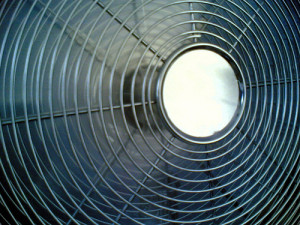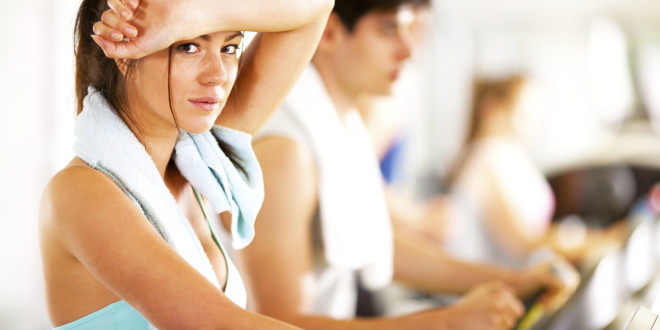by Michelle Sutton-Kerchner
Perspiring is a nuisance. Here are the cool(ing) facts of how and why sweat happens. You’ll be ready to burn off those calories …
The Science Behind the Sweat
Two types of sweat glands exist: eccrine and apocrine. Eccrine glands are located over most of the body and open directly onto the skin’s surface. Their purpose is to regulate body temperature. When body temperature rises, the nervous system stimulates these glands to release perspiration, which contains water, sodium, and other substances. The water in this concoction evaporates on the skin’s surface to cool the body.
Apocrine glands empty onto the skin via hair follicles. They are found mainly in the underarm and groin regions. Stress, anxiety, and fluctuating hormones trigger these glands to contract and release perspiration, which contains water, protein, fatty acids, and other substances. Both types of perspiration mix on the skin where natural bacteria causes the apocrine solution to break down and release body odor. (Hence, the need for deodorant under the arm rather than all over.)
Telltale Fitness Indicator?
How much you sweat is determined by several factors, including gender, genetics, age, environment, and fitness level. The average person has three million sweat glands, though the range is from two to four million. More glands mean more sweat production. But don’t sweat over it– a personal training evaluation and nursing assessment can accurately determine your fitness level.
Fitness level is only one factor in determining your sweat patterns. Often, a person who is overweight sweats more because the body must exert more energy to accomplish daily functions. Additionally, more body mass means more to cool. A study published in the Journal of Applied Physiology showed sweat rates depended on heat production, which was based on factors like body size and environment, not cardiac fitness. Participants with overall higher fat content and body mass were likely to produce more heat, which resulted in increased sweat production.
Conversely, a fit person also tends to sweat easily. With improved physical fitness, the body functions more efficiently, including the ability to regulate its temperature. Sweating at lower body temperatures cools the body quicker. This stores less heat within, reducing the dangers of overheating. The American Council on Exercise indicates fit people tend to sweat earlier in a workout when body temperature is lower so their bodies don’t store extra heat.
One theory suggests the increase in blood volume demanded during exercise helps perspiration production. The boost in plasma volume caused by exercise encourages a good, healthy sweat. Get your blood pumping more often and increase the efficiency of perspiration production.
With all these factors contributing to a person’s sweat production, one cannot confidently use perspiration as an indicator of fitness or shedding pounds. Sweat is not essential to weight loss. Purposely dressing in heavier clothes and exercising in the heat doesn’t lead to a smaller waist size by the weekend. And, it can be dangerous. These conditions increase the chance of dehydration through excess water loss.

Heavy workout wear (sweatsuits) or too many layers can trap body heat, preventing perspiration from its cooling function. High humidity also can interfere with sweat’s evaporation. When the air is heavy with moisture, even low-intensity routines can be a struggle. Wear sweat-wicking fabrics and work out where air circulation is good. Use a fan, especially if ventilation is lacking. When exercising, you should not become so hot that sweat drips profusely. It needs to evaporate on the skin to be effective. It is also best to avoid wiping away sweat.
The body sweats continuously, though you may not realize it. Moisture is released over almost the entire skin to keep you comfy at your normal temp of 98.6, or thereabouts. To accomplish this on a hot day, you may sweat without lifting a finger. So much for drenched clothes giving fitness bragging rights.
Underarm Yourself
Sweating is a fact of life. An avid exerciser or athlete knows this more than anyone. Their bodies frequently work hard to cool off from physical exertion. Hence, a workout being dubbed a “sweat session.” Despite being commonplace, even the most confident may feel self-conscious about sweat marks and stinky gym clothes.
Dermatologist best advice: Shower with a triclosan-containing (antibacterial) deodorant soap. Lather and repeat as necessary. Then, apply an antiperspirant/deodorant combination that contains a high concentration of aluminum chloride. This adheres to, and blocks, sweat glands.
If you sweat profusely without explanation (e.g., exercise, hot temperatures, or anxiety-provoking scenarios), it may signal hyperhidrosis. Hyperhidrosis disrupts daily routines and can be embarrassing. Prescription antiperspirant is usually the first defense, followed by more aggressive treatment, if needed, ranging from injections to surgery in severe cases.
For some with hyperhidrosis, operation of a car’s steering wheel and other mundane tasks can be affected by slippery sweat that literally drips from the hands. Sweating especially occurs in feet, underarms, hands, and, less frequently, the face. This disorder of overactive nerves connected to the sweat glands affects about eight million Americans. Those who suffer it endure the added symptom of social anxiety or embarrassment. (One can’t always wear workout clothes to explain away wet marks.)
If sweating becomes extreme or is accompanied by a change in odor, see your physician. It may be a sign of more serious health concerns.
Sweat It Out
The next time you feel those little beads forming on your forehead, or that trickle down your back, marvel at the millions of sweat glands working to cool you. Go ahead and sweat it! Carry on with confidence.
Sources
“7 Signs of Excessive Underarm Sweat,” by Beth W. Orenstein at www.everydayhealth.com.
www.livestrong.com
www.mayoclinic.com
 Fitness & Wellness News Your Source for Fitness News, Wellness News, Health News, and Nutrition News!
Fitness & Wellness News Your Source for Fitness News, Wellness News, Health News, and Nutrition News!




